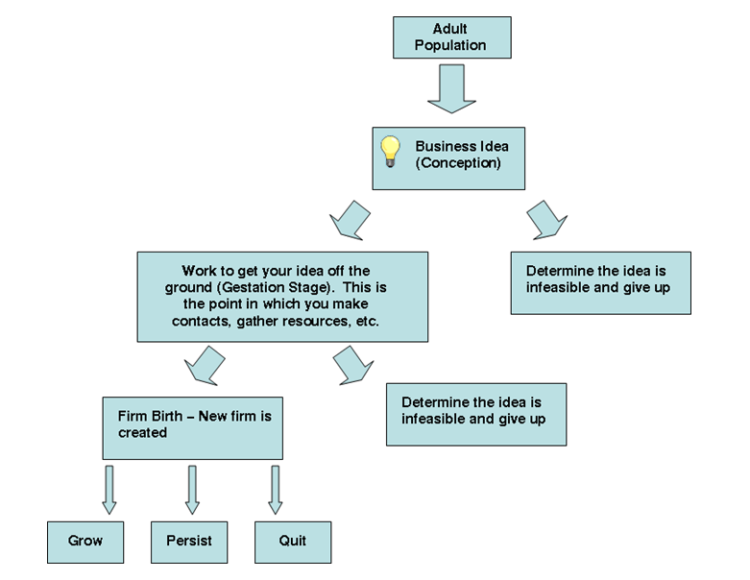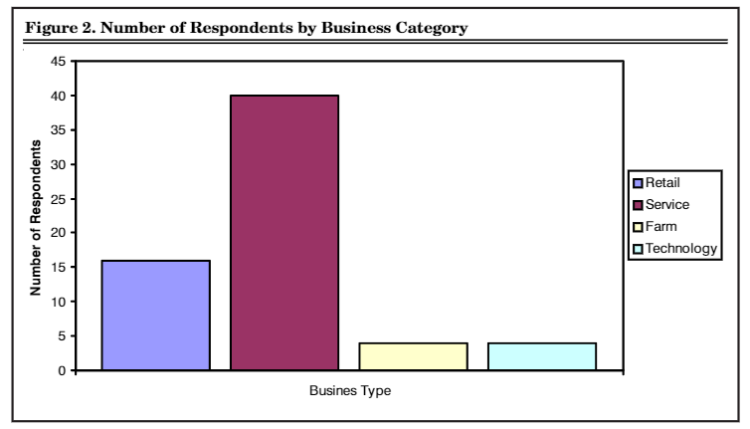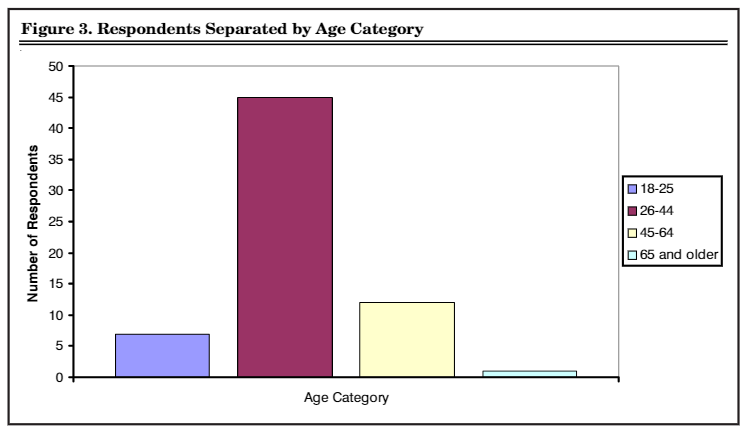Demystifying Hoosier Entrepreneurs
February 18, 2007
PAER-2007-01
Maria Marshall, Assistant Professor and Whitney Peake, Graduate Student
The Small Business Development Administration (2006) reports that small firms represent 99.7% of all employers in the U.S., and have generated 60% to 80% of the net new jobs over the past decade. These figures suggest that the entrepreneurs behind these small businesses are essential to the economy. Despite their importance to the economy at both the state and national level, entrepreneurs really are a rather mysterious group. Some make it big, others make it small, while some don’t make it past the idea stage. Since entrepreneurs come in so many shapes and sizes in terms of businesses and success rates, it is difficult to understand what exactly makes some entrepreneurs more successful than others.
One thing research has shown is that entrepreneurs cycle through a development process when cultivating their business ideas. Below is a depiction of the development process entrepreneurs typically follow in starting a new business based on a similar diagram from Reynolds et al (2004).
Since the Gestation Stage is a time during which entrepreneurs make some of their most crucial decisions, this appears to be an opportune time during the process to gain information about the factors that contribute to business start-up.
To identify entrepreneurs in the Gestation Stage, we distributed surveys to individuals attending Purdue University affiliated entrepreneurship workshops and Small Business Development Center seminars throughout Indiana.
One hundred twenty-eight entrepreneurs were contacted through these workshops, and sixty-five of those individuals agreed to participate in our study. Several interesting characteristics of the respondents were determined.

Table 1.
Entrepreneur Characteristics
Of those participating in the study 26% had actually started a business, which indicates they had moved from the gestation stage into firm birth. Seventy-four percent of respondents were still working towards getting their business off the ground (See figure 1).
When the entrepreneurs were broken down by business category (figure 2), the service industry outnumbered the other business types, which is what we would expect since the service industry continues to increase in size within the U.S. Approximately 26% of respondents’ businesses were retail-related, 66% were service-related, 6.6% were farm-related, and 6.6% were technology-related.
One important aspect to consider is the age category into which Hoosier entrepreneurs tend to fall. The 26-44 year category is the highest, consisting of nearly 70% of the entrepreneurs surveyed (See figure 3).

Figure 1. Percentage of Participants Who Have Started a Business Versus Those Who Are Still Trying
Within previous studies, males have generally been found to outnumber females (Reynolds et al, 2004). Indiana nascent entrepreneurs, however, differ quite markedly from previous studies, in that females constitute over half of the respondents (See figure 4).
Other results revealed that 78% of respondents were white, 18% were black, and the remaining 4% fell into other racial categories. An astounding 88% of the entrepreneurs had completed at least some college education. Fifty-eight percent of those surveyed had attempted to create a business plan, and 42% had parents that were self-employed. Fifty-seven percent of respondents had a net worth of $75,000 or more, while 72% had already made business resource contacts while working towards firm birth.
Factors Contributing to Launch of a Business
Based on the data obtained from the sixty-five survey respondents, five key elements were found to significantly impact an entrepreneur in reaching the firm birth stage of the entrepreneurial process*.
- Presence of a major retail chain
Having a major retail chain, such as Wal-Mart, Target, or K-Mart was found to increase the chances of starting a business by 18%. We believe this suggests a community that has the infrastructure to support a major retail chain may also have the infrastructure to support many small businesses.

Figure 2. Number of Respondents by Business Category
- Education level
Having obtained a graduate degree was found to increase the chances of starting a business by 94.5%. Like many other studies before ours, this demonstrates that education, which is sometimes referred to as human capital, is an important factor in entrepreneurship.
- Business plan attempt
Having attempted a business plan was discovered to increase the chances of starting a business by 24%, which indicates that business plan writing workshops and seminars may very well be worth entrepreneurs’ time.

Figure 3. Respondents Separated by Age Category
- Net worth
Having a net worth of $50,000 to $75,000 was found to increase the chances of starting a business by 74%, while having a net worth of $100,000 or more increase the chances of starting a business by 42%. These results indicate that money and access to assets do benefit entrepreneurs in starting their businesses. However, those with fewer assets may be looking for a way to increase their income level through investment in a small business.
- Household ownership
Owning a house was actually found to decrease the chances of starting a business by 6%. This may be linked to a hesitance to take risk, but this result is fairly uncertain since it actually runs contrary to what we would have predicted. A nation-wide study similar to ours received inconclusive results with regards to the effects of household ownership (Reynolds et al, 2004).

Figure 4. Respondents Separated by Gender
Concluding Comment
Although these results do not tell us everything we need to know to
understand entrepreneurs in Indiana, they do give us insight into both some basic characteristics they possess and factors that impact moving the business past the idea stage. From the elements that significantly impact the likelihood of starting a business, we can make several larger generalizations. A community that has sufficient infrastructure to support some larger businesses will likely also be able to support smaller ones as well. In addition, education, planning, and financial resources are essential to entering the firm birth stage. Without those elements the business is fairly unlikely to ever get off the ground.
References
Reynolds, P.D., Carter, N.M., Gartner, W.B., and P.G. Greene. “The Prevalence of Nascent Entrepreneurs in the United States: Evidence from the Panel Study of Entrepreneurial Dynamics.” Small Business Economics 23 (2004): 263-284.
